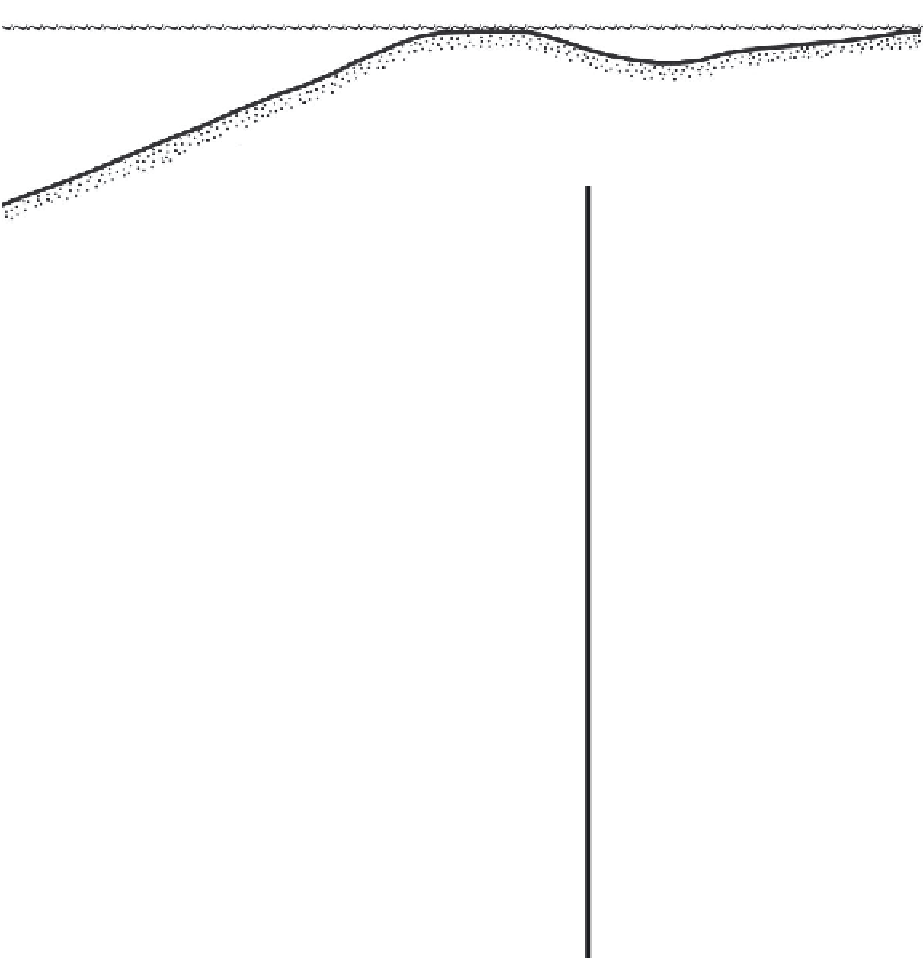Geology Reference
In-Depth Information
Forereef
Backreef
Wave base
Reef core
I-f
II-f
III-f
IV-f
IV / V
V
IV-b
III-b
II-b
I-b
A
Water
quiet water
intermittently slightly
moderately
strongly
moderately
slightly
intermittently intermittently
energy
below
agitated
agitated
agitated
agitated water
agitated
agitated
agitated
agitated
wave base
water
water
water
water
water
water
water
Turbulence negligible
episodic
moderate
strong
strong
strong
moderate
episodic
episodic
Rounding
original
poor
moderate
good to
very good to moderate
good to
moderate
poor to
original
fossil shapes
to good
to good
moderate
moderate
to good
good
fossil shapes
Sorting
angular frag
matrix: good, matrix:
good to
matrix: moderate
good to
matrix:
matrix: good angular frag
ments if
fossils: poor moderate,
moderate
fossils: poor
moderate
moderate
fossils: poor ments if
broken
to good
fossils: mod
fossils: mod to good
broken
erate to good
erate to good
B
Texture
packstones,
packstones, floatstones,
rudstones,
rudstones,
bindstones, rudstones,
floatstones,
packstones, mudstones,
grainstones,
grainstones, grainstones, baffle
bindstones, frame
bafflestones
grainstones, grainstones wackestones
mudstones
rare
rare
stones
rare
stones,
rare rud
floatstones
rudstones
grainstones rudstones
stones
C
Amount of
-> -> -> primary micrite decreasing -> -> ->
fibrous calcite,
-> -> -> primary micrite increasing -> -> ->
micrite
sparite, micrite
D
Porosity
intraparticle
intraparticle, interparticle, shelter
shelter
shelter
shelter
shelter
intraparticle, intraparticle,
types
interparticle
shelter voids, voids,
voids,
voids,
voids,
voids,
interparticle, fenestral
intraparticle
growth
interparticle growth
growth
intraparticle,
fenestral
framework,
framework, framework,
interparticle
interparticle
interparticle interparticle
Pore size
small
medium
medium
large to
medium
large to
medium to
small
to small
to small
medium
to small
medium
small
Porosity
below 10%
up to 1%
up to 15%
up to 10%
up to 25% up to 10%
up to 40%
up to 10%
up to 20%
up to 30%
mostly < 5%
E
Fossil
calcispheres, small
large
tabulate
crinoids,
bulbous +
Stachyodes, Amphipora,
algae
algae
assemblage foraminifera
crinoids
crinoids
corals,
tabular
massive
Girvanella,
Parathuram (fenestral
(fenestral
Stachyodes, stromato
stromato
Renalcis
mina,
pores)
laminites)
brachiopods, poroids
poroids,
ostracods
crinoids,
micrite en
Girvanella,
velopes,
Renalcis
syntaxial
rim cement
F
Indicator
crinoids / goniatites / brachiopods
crinoids, Solenopora,
Amphipora / calcispheres | Parathurammina /
fossils
Keega
Vermiporella / encrusting Sphaerocodium
Fig. 14.9.
Facies model for Middle and Late Devonian reef carbonates
after Machel and Hunter (1994). The model differentiates
five water energy zones with increasing water energy from I to V, designated as either f (forereef) or b (backreef). Use of the
model requires an estimation of frequencies, differentiation of growth forms and some knowledge of fossils. Part
A
estimates
water energy by noting rounding and sorting. Part
B
refers to the limestone texture. Part
C
records the amount of micrite.
Part
D
lists the amount, size and the predominant type of porosity. Part
E
lists assemblages that are common in the different
facies zones and have their distributional maxima within the zone(s). Part
F
lists 'indicator fossils' which are usually found
only in backreef, forereef, or reef core settings. The criteria used in distinguishing facies zones can be observed in outcrops,
cores as well as in large thin sections. See Fig. 14.8 to see how the model is applied.
Fig. 14.10.
The
location of reef growth and the development of the reef zones
depend on the submarine topography. In the
case of a more gently dipping slope, maximum reef growth is located deeper than in the example shown in Fig. 14.9. The
shallow forereef zone IV-f is missing or only incompletely developed. After Machel and Hunter (1994).































